Topic 8: Transport in Plants
1/32
There's no tags or description
Looks like no tags are added yet.
Name | Mastery | Learn | Test | Matching | Spaced |
|---|
No study sessions yet.
33 Terms
Describe xylem.
A hollow plant tissue made up of dead, empty cells joined end to end. It has no contents such as nuclei or cytoplasm and no cross walls.
What is the function of the xylem?
They transport water and mineral ions from the roots and up to the leaves.
They help support the plant through their walls of cellulose and strong lignin.
Describe the phloem.
A plant tissue made up of living cells joined end to end.
What is the function of the phloem?
They transport sucrose and amino acids from the leaves where they are made, to other parts of the plants, such as its roots and flowers.
What do the xylem and phloem compose of?
A transport system known as the Vascular Bundle.
Define the source.
The part of the plant that releases sucrose & amino acids, to be transported to other parts of the plant.
Define the sink.
The part of the plant to which sucrose and amino acids are being transported to, to which they are used or stored.
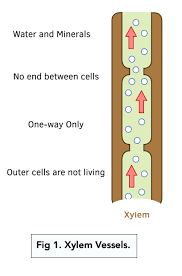
What is the structure of the xylem tissues/vessels?
It has thick walls that are strengthened with lignin, which provides support and helps the vessels withstand the pressure of water moving upwards. They have no cell contents, which means there is no obstruction to the flow of water. The xylem cells are joined end to end with no cross walls, forming a long, continuous tube that allows water and mineral ions to flow easily from the roots to the leaves.
Define conduction.
The upwards transport of materials in the xylem tissues.
Pathway of water through a plant
Root hair cell -> Root cortex cells -> Xylem -> Mesophyll Cells
Define transpiration.
The process by which plants lose water from the leaf. At the surface of the mesophyll cells followed by diffusion from the air spaces to the atmosphere, through the stomata as water vapor.
Why is transpiration important?
It transports minerals, cools down leaves, and provides water for structure & photosynthesis.
What is transpirational pull?
When water is constantly taken from the top of the xylem to supply leaves, it reduces the pressure up there. This means there's a pressure difference of the xylem vessel near the leaves and the xylem vessel near the roots, causing water to flow upwards from higher pressure at the bottom to lower pressure at the top, due to water molecules sticking together due to high forces of attraction.
What are the three factors that affect the rate of transpiration?
Temperature, Wind Speed, Humidity
How does temperature affect the rate of transpiration?
The higher the temperature, the greater the kinetic energy of water molecules, meaning that water will evaporate more quickly from the surface of mesophyll cells and diffuse out of the leaf and into the air more quickly.
How does humidity affect the rate of transpiration?
An increase of humidity means less water vapor will diffuse out of the leaf because there is not much of a diffusion gradient for the water vapor between the air spaces inside the leaf and the wet air outside.
How does Wind Speed affect the rate of transpiration?
Increased wind speed increases the rate of transpiration. On a windy day, the air around the leaf, which has a lot of water vapor, is quickly moved away. This creates a diffusion gradient because there is less water vapor outside the leaf than inside. Thus, water vapor diffuses out of the leaf faster on windy days than on still days.
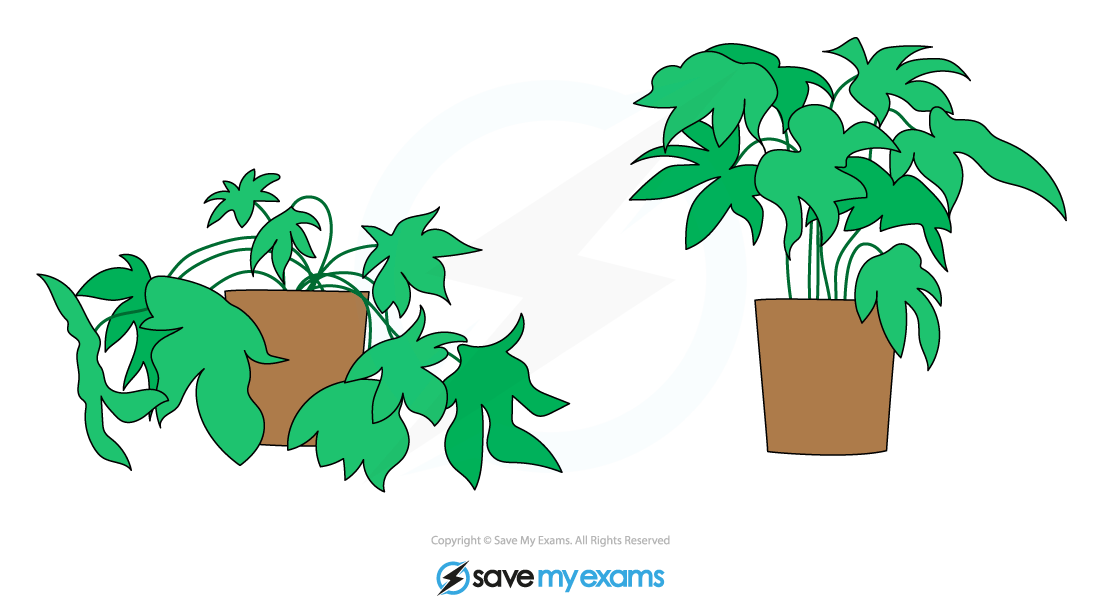
Define wilting.
When plants lose water from their leaves faster than it can take up from the roots. The cells in the plants lose so much water they become flaccid and the tissues in the leaves are no longer supported by the turgid cells pushing outwards on one another, causing them to droop and be soft and floppy.
Define translocation.
The movement of sucrose and amino acids in the phloem from sources to sinks.
What do root hair cells increase the rate of absorption for?
Water by osmosis & Mineral ions by active transport.
Define cohesion.
The force of attraction between similar particles.
Define adhesion.
The force of attraction between different particles.
What is the function of a root hair cell?
To absorb water and mineral ions from the soil.
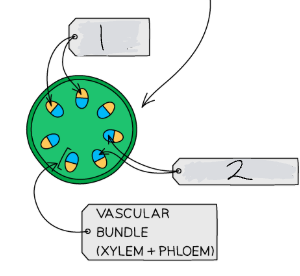
In the cross-section of a stem, what is the 1?
Phloem
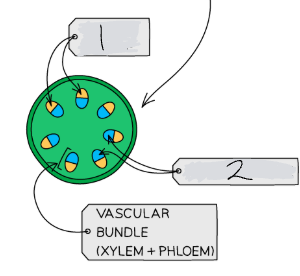
In the cross-section of a stem, what is 2?
Xylem
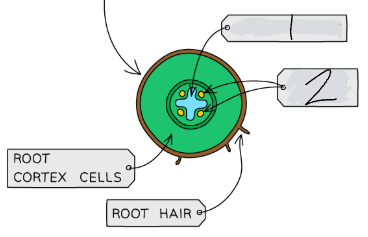
In the cross-section of a root, what is 1?
Xylem
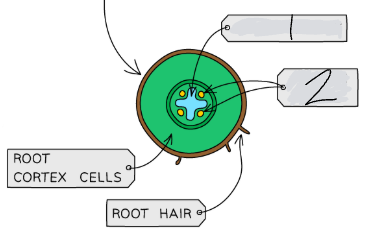
In the cross-section of a root, what is 2?
Phloem
Why can some parts of a plant be both the sink and source at different times?
During growth, the roots be the source of nurtients to the other parts of the plant (ex. leaves).
After growth, the leaves can photosynthesize and they become the source and the roots becomes the sink.
How does water from the soil move into the root hair?
Through osmosis. The water in the soil is more dilute while the cell sap and cytoplasm inside the root hair is more concentrated.
So, they move from a high water potential to a low water potential down the water potential gradient through the partially permeable cell surface membrane.
How do mineral ions move into the root hair cell?
Through active transport, from a low concentration in the soil to a high concentration inside the root hair cell against the concentration gradient using energy from respiration in the mitochondria of the root hair cell.
How are root hair cells specially adapted to absorb water and mineral ions?
Their large surface area increases the uptake of water & mineral ions.
What causes the transpiration pull in xylem vessels?
Water evaporates from the surface of mesophyll cells and diffuses out through the stomata during transpiration. This creates a pull on the water column in the xylem vessels, known as the transpiration pull. Water molecules are held together by cohesion — forces of attraction between them. This allows them to form a continuous column from the roots to the leaves. As water is pulled up, more water enters the roots by osmosis, maintaining the flow.
How does the internal structure of a leaf helps in the evaporation of water?
The mesophyll layer in a leaf contains many interconnecting air spaces, which creates a large internal surface area. This increases the area over which water can evaporate from moist cell walls into the air spaces. The more surface area, the more water can evaporate. Water vapour then diffuses out of the leaf through the stomata. If the stomata are large or numerous, more water vapour can escape at once. Therefore, water vapour loss increases with more air space and more or larger stomata.